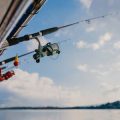1. Introduction to Feeder Fishing in Britain
Feeder fishing holds a special place in the hearts of British anglers, weaving together centuries-old traditions with contemporary innovation. Across the UK, this popular angling technique has evolved from its humble beginnings on tranquil rivers and canals to become a staple on commercial fisheries and picturesque lakes. The roots of feeder fishing can be traced back to local communities where resourceful anglers crafted homemade feeders and developed their own unique approaches based on regional waters. Today, the diversity of feeder fishing is celebrated throughout England, Scotland, and Wales—each region boasting its own preferred methods, target species, and time-honoured customs. Whether it’s the classic quiver tip rod used along the River Trent or the latest high-tech setups found at modern-day match venues, feeder fishing continues to unite generations of enthusiasts who share a passion for both tradition and innovation on the bank.
2. Traditional Feeder Setups: A Walk Down Memory Lane
For many British anglers, the charm of feeder fishing lies in its rich heritage and the classic setups that have stood the test of time on UK waters. Before modern innovations swept through tackle shops, generations of local fishermen honed their craft with simple yet highly effective methods. Let’s explore these traditional feeder setups, delving into the gear, rigs, and techniques that continue to hold a special place on Britain’s riverbanks and lakesides.
Classic Gear and Tackle
Traditional British feeder fishing typically revolved around sturdy yet sensitive rods, reliable centrepin or fixed spool reels, and well-crafted cage or open-ended feeders. The emphasis was always on durability and finesse—a balance that allowed for gentle casting and precise bait presentation. Below is a snapshot comparing key elements of classic setups:
| Component | Traditional Choice | Typical Use |
|---|---|---|
| Rod | 10-12ft glass fibre or early carbon rods | Sensitive tip for bite detection, enough backbone for larger coarse fish |
| Reel | Centrepin or fixed spool with slow retrieve | Offers control during both casting and playing fish |
| Feeder Type | Cage or open-end feeders (metal/plastic) | Holds groundbait firmly; releases slowly in current or stillwater |
| Main Line | 4-6lb mono line | Smooth casting; enough strength for most coarse species |
| Hooks & Rigs | Size 14-18 hooks; running or helicopter rig style | Subtle bait presentation for wary roach, bream, and tench |
Old-School Techniques & Wisdom
The hallmark of traditional British feeder fishing is its focus on watercraft—reading the water, picking likely swims, and adjusting tactics to suit changing conditions. Seasoned anglers relied on groundbait recipes passed down through generations, often mixing breadcrumb, hempseed, and sweetcorn to attract a variety of native coarse fish.
Tried-and-Tested Practices Include:
- Pre-baiting: Building a swim gradually with small amounts of feed to draw fish in without overfeeding.
- Bite Watching: Using quivertip rods to spot delicate bites from shy species like dace or skimmers.
- Pace Control: Varying the frequency of casts and adjusting feeder size depending on flow rate and fish activity.
- Bait Selection: Opting for maggots, casters, worms, or bread flake—simple but deadly choices favoured by generations past.
A Lasting Legacy on UK Waters
The beauty of these traditional setups lies in their simplicity and adaptability—an approach that’s just as relevant today on classic venues like the River Trent or Fenland drains as it was fifty years ago. For many British anglers, there’s a nostalgic satisfaction in keeping old-school methods alive alongside more modern alternatives—a true celebration of angling heritage.

3. Modern Innovations in Feeder Fishing
While tradition holds a special place on the British bank, the world of feeder fishing has seen a wave of modern innovations that have truly transformed the angling experience. Today’s tackle boxes are packed with lightweight carbon-fibre rods, ultra-sensitive bite alarms, and compact reels designed for both precision and comfort. These advancements make it easier to cast further and detect even the subtlest nibble – perfect for those targeting wary fish in busy British waters.
Bait choices have also evolved, moving beyond classic maggots and sweetcorn. Innovative groundbaits infused with unique attractants, brightly coloured pellets, and artificial baits are now commonplace. Many younger British anglers are embracing these options, influenced by pop culture and the increasing popularity of competitive match fishing seen on platforms like YouTube and Instagram. This shift is creating a vibrant community that’s keen to experiment and share their catches online.
Technology plays a huge role too. Apps for weather tracking, water temperature monitoring, and even digital logbooks help anglers plan their sessions more effectively than ever before. Social media groups and forums connect enthusiasts nationwide, allowing trends to spread rapidly – whether it’s the latest must-have method feeder or a new rig tying technique. The result? A dynamic scene where tradition meets trendsetting innovation, keeping British feeder fishing both exciting and accessible for all generations.
4. On the Bank: Comparing Performance in Real British Waters
For many UK anglers, the true test of any feeder fishing setup is how it fares on the bank, along the storied gravel pits of Essex or the winding canal banks of the Midlands. Traditional and modern approaches both have their champions, but performance can vary dramatically depending on venue, weather, and target species. By getting hands-on at classic British locations, we can see how each method stacks up under real conditions.
Gravel Pits: Depths and Distance
Traditional setups—think quiver tip rods with open-end feeders—are often favoured for their reliability when targeting bream and tench in deeper waters. Their simplicity makes them ideal for casting moderate distances and feeling subtle bites. Modern setups, however, frequently employ lighter rods with inline or method feeders, allowing for greater casting accuracy and a more streamlined presentation.
| Feature | Traditional Setup | Modern Setup |
|---|---|---|
| Casting Distance | Moderate (50-70m) | Long (up to 100m+) |
| Bite Detection | Quiver tip sensitivity | High-tech indicators & fine tips |
| Feed Presentation | Loose groundbait, less precise | Packed method/feeders, highly targeted |
| Adaptability | Limited by rod/feeder weight | Easily adjusted for depth & flow |
Canal Banks: Precision and Stealth
On narrow canals where silverfish rule, traditionalists often reach for light feeder rods paired with cage feeders. This approach allows for gentle bait delivery and minimal disturbance—crucial when wary roach or skimmers are the quarry. In contrast, modern gear with slim carbon blanks and mini method feeders provides exceptional control for pinpoint casts beneath overhanging willows or close to moored boats.
Key Observations from the Bank:
- Bite Rate: Modern setups typically outpace traditionals on busy day-ticket venues where pressure demands finesse.
- Ease of Use: Beginners find traditional kits less intimidating, while seasoned match anglers extract maximum performance from cutting-edge gear.
- Venue Suitability: Traditional rigs shine on wild venues with minimal angling pressure; modern rigs excel in competitive or commercial fisheries.
A Balanced Approach?
The most successful British anglers often blend both worlds—using sturdy classics on expansive gravel pits during early morning sessions, then switching to ultra-modern tackle as daylight brightens and fish become finicky. Ultimately, hands-on experience across diverse venues reveals that neither setup is universally superior: adaptability is key on British waters.
5. Comfort, Convenience, and the British Weather
If you’ve ever spent a day feeder fishing on a classic British lake, you’ll know that comfort and convenience are just as important as catching fish—especially when the heavens open or a chilly wind whips across the water. So, how do traditional and modern feeder fishing setups compare when it comes to making your session enjoyable under those famously unpredictable British skies?
Traditional Tackle: Rugged but Restrained
Many seasoned British anglers swear by the tried-and-tested charm of older setups—think sturdy cane rods, wooden seat boxes, and canvas umbrellas. While these can feel reassuringly solid and nostalgic, they often come up short in terms of ease of use. Adjusting a vintage umbrella mid-shower can be fiddly, and classic gear is heavier to lug along muddy towpaths. If you’re after an old-school vibe, prepare for a bit more elbow grease—and perhaps a soggier experience if the weather turns foul.
Modern Gear: Designed for Drizzle and Ease
Contemporary feeder fishing kits seem tailor-made for the UK’s changeable climate. Lightweight carbon fibre rods, padded chairs with built-in rod rests, and quick-erect shelters make setting up a doddle even when clouds are gathering. Many modern seat boxes have cleverly integrated storage, so you’re not rummaging for bait in the rain. The latest waterproofs and breathable fabrics also mean you’ll stay dry without sweltering inside your jacket—vital for those marathon sessions on the banks of the Trent or Avon.
Practical Features for British Anglers
Features like adjustable legs on chairs (ideal for uneven ground), magnetic closures on tackle bags (for one-handed access), and storm-proof brollies all add up to a more comfortable session. It’s no wonder many UK anglers are drawn to these innovations when faced with four seasons in one day.
The Verdict: Blending Tradition with Modernity
Ultimately, whether you favour the romanticism of traditional tackle or the creature comforts of modern gear, comfort and convenience are key to enjoying feeder fishing in Britain’s varied weather. For many, a hybrid approach—pairing a classic rod with a state-of-the-art shelter—offers the best of both worlds, letting you savour nostalgia while staying dry and relaxed whatever the forecast throws your way.
6. The Angler’s Perspective: Local Insights & Community Voices
If there’s one thing that defines British fishing culture, it’s the camaraderie and tradition found on the banks of local rivers, lakes, and canals. When it comes to feeder fishing setups, conversations at tackle shops or beside a misty dawn swim reveal a tapestry of opinions and experiences. Many club regulars in the Midlands still swear by traditional quiver tip rods paired with open-end feeders, claiming these methods “just feel right” for classic bream or tench sessions. They’ll tell you, “If it ain’t broke, why fix it?”—especially when these tried-and-tested setups have bagged them trophies at Sunday matches for decades.
However, younger match enthusiasts or those frequenting commercial fisheries tend to be more experimental. You’ll hear about hybrid feeders, quick-change rigs, and ultra-light carbon rods that make every twitch on the line exhilarating. Modern advocates say these advances give them “an edge on pressured waters,” especially when targeting wary F1s or carp in well-stocked venues. Some even credit their PBs (personal bests) to switching from old-school cage feeders to inline flatbed methods that present bait more naturally.
The real heart of British angling lies in its community spirit. Whether over a pint at the village pub or during weigh-ins at local leagues, anglers share tips and debate what works best. For some, nostalgia and ritual play as much a role as results; for others, innovation is about staying ahead in fiercely competitive matches. Ultimately, most agree that both traditional and modern approaches have their place on UK waters—what matters most is understanding your venue, your target species, and most importantly, enjoying the day out beside the water with mates.
7. Conclusion: Blending Tradition and Innovation for the Perfect Day Out
When it comes to feeder fishing in Britain, there’s no need to choose sides between tradition and modernity. Both traditional and modern feeder fishing setups have their place on UK waters, whether you’re casting into a tranquil canal in the Cotswolds or targeting bream on the banks of the mighty River Trent. Embracing elements from each approach can elevate your angling experience, offering flexibility, efficiency, and a dash of nostalgia that makes a British day out by the water so special.
The Best of Both Worlds
Traditional setups – think classic quiver tip rods, centrepin reels, and hand-tied rigs – provide a hands-on, immersive connection to the water that many British anglers cherish. They’re perfect for those who enjoy slowing down, soaking up the scenery, and relishing the subtlety of every bite. On the other hand, modern gear like precision-engineered feeders, high-tech bite alarms, and advanced monofilaments can make all the difference when you’re tackling larger venues or looking to maximise your catch rate.
Tips for Choosing Your Setup
- Match Your Gear to the Venue: For intimate club lakes and slow-moving rivers, traditional tackle can offer just the right touch. On vast reservoirs or commercial fisheries, modern rigs often come into their own.
- Consider Your Target Species: Carp specialists may benefit from innovative methods and materials, while silverfish enthusiasts might prefer time-honoured techniques.
- Factor in Weather & Conditions: In true British fashion, be prepared for anything! Modern setups tend to cope better with wind and rain thanks to robust engineering.
- Add a Personal Touch: Don’t be afraid to mix and match. Combine an old-school rod with a new feeder design or experiment with contemporary hookbaits alongside vintage groundbait recipes.
Your Perfect Fishing Adventure Awaits
No matter where your travels take you across Britain – from scenic rural ponds to bustling city canals – blending tradition with innovation ensures every session is rewarding. The real magic lies in tailoring your approach to suit both the fishery and your personal style. So pack your flask of tea, don your wellies, and set off with confidence: whether you favour heritage or hi-tech, British feeder fishing offers endless possibilities for discovery and relaxation by the water’s edge.


